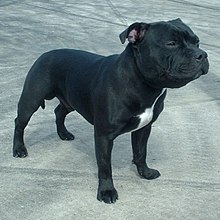Staffordshire bull terrier
 |
||||||||||||||||||||||||||
| Common nicknames |
|
|||||||||||||||||||||||||
|---|---|---|---|---|---|---|---|---|---|---|---|---|---|---|---|---|---|---|---|---|---|---|---|---|---|---|
| Origin | England | |||||||||||||||||||||||||
|
||||||||||||||||||||||||||
|
||||||||||||||||||||||||||
| Domestic dog (Canis lupus familiaris) | ||||||||||||||||||||||||||
| Traits | |||
|---|---|---|---|
| Weight | Male | 13 to 17 kg (29 to 37 lb) | |
| Female | 11 to 15.4 kg (24 to 34 lb) | ||
| Height | Male | 36 to 41 cm (14 to 16 in) | |
| Coat | Smooth, short and close | ||
| Colour | Red, fawn, white, black or blue, or any one of these colours with white; any shade of brindle; any shade of brindle with white | ||
| Classification / standards | |||
|---|---|---|---|
| FCI | Group 3, Section 3 Bull Terriers #76 | standard | |
| AKC | Terrier | standard | |
| ANKC | Group 2 (Terriers) | standard | |
| CKC | Group 4 - Terriers | standard | |
| KC (UK) | Terrier | standard | |
| NZKC | Terrier | standard | |
| UKC | Terriers | standard | |
The Staffordshire Bull Terrier is a medium-sized, short-coated breed of dog. It is of English lineage and may be considered to be within the pit bull type.
Before the 19th century, blood sports such as bull baiting, bear baiting and cock fighting were common. At the cattle market, bulls were set upon by dogs purportedly as a way of tenderising the meat and providing entertainment for the spectators. Fights with bears and other animals were also organised as entertainment.
The early bull and terrier types were not bred to resemble the breeds of today, but rather for the characteristic known as gameness, with the pitting of dogs against bear or bull; testing the strength and skill of the dogs. Landrace working dogs crossbred with bulldogs provided the ancestral foundation stock for the Staffordshire Bull Terrier. These bloodsports were officially eliminated in 1835 as Britain began to introduce animal welfare laws. A dog fighting another dog was cheaper to organise and easier to conceal from the law. Dog fighting involved gambling and a way to continue to test the animal; dogs were released into a pit, and the last dog still fighting or surviving was recognised the winner.
The modern breed is one that has a temperament ideally suitable for a companion dog. It is a dog worthy to show and was accepted by The Kennel Club of the United Kingdom as the Staffordshire Bull Terrier in 1935.
The breed attained recognition by the Kennel Club on 25 May 1935. The Staffordshire Bull Terrier Club was formed in June 1935, one month after the breed was recognised by the Kennel Club. It is unusual for a breed to be recognised without a club in existence first, and even more unusual for there not to have been a breed standard in place. A standard was not drawn up until June 1935 at the Old Cross Guns, a Black Country pub in Cradley Heath in the West Midlands. A group of 30 Stafford enthusiasts gathered there and devised the standard, as well as electing the club's first secretary, Joseph Dunn, a well-known figure connected with the breed. Challenge certificates were awarded to the breed in 1938, and the first champions were Ch. Gentleman Jim (bred by Joseph Dunn) and Ch. Lady Eve (owned by Joseph Dunn), both taking titles in 1939. During the 1980s owners started to breed from old British lines also importing Staffordshire Bull Terriers from Ireland which they believed to be truer to the original of the pre showing days. These dogs are often referred to as Irish Staffordshire Bull Terriers. Media reports often refer to this as a cover name for breeders to sell pitbulls illegally.
...
Wikipedia
